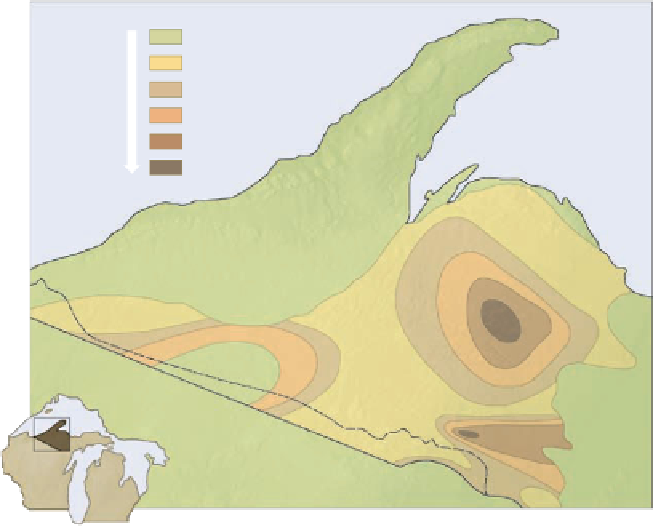Geology Reference
In-Depth Information
Metamorphism
Quartz sandstone
Quartzite
◗
Figure 7.17
Quartzite Results from the Metamorphism of the Sedimentary Rock Quartz Sandstone
zones based on the presence of distinctive silicate mineral
assemblages. These mineral assemblages, each recognized by
the presence of one or more telltale index minerals, indicate
different degrees of metamorphism. The index minerals
that Barrow and his associates chose to represent increasing
metamorphic intensity were chlorite, biotite, garnet, stau-
rolite, kyanite, and sillimanite (Figure 7.8), which we now
know all result from the recrystallization of clay-rich sedi-
mentary rocks. As we already mentioned, other mineral
assemblages and index minerals are produced from rocks
with different original compositions.
The successive appearance of metamorphic index
minerals indicates gradually increasing or decreasing intensity
of metamorphism. Going from lower- to higher-grade meta-
morphic zones, the fi rst appearance of a particular index min-
eral indicates the location of the minimum temperature and
pressure conditions needed for the formation of that mineral.
When the locations of the fi rst appearances
of that index mineral are connected on a
map, the result is a line of equal metamor-
phic intensity or an
isograd
. The region be-
tween two adjacent isograds makes up a
single
metamorphic zone
—a belt of rocks
showing roughly the same general degree of
metamorphism. Through mapping a series
of adjoining metamorphic zones, geologists
can reconstruct metamorphic conditions
across entire regions (
example, the green metamorphic mineral chlorite, which
forms under relatively low temperatures and pressures, yields
rocks belonging to the
greenschist facies
. Under increasingly
higher temperatures and pressures, mineral assemblages in-
dicative of the
amphibolite
and
granulite facies
develop.
Students in their initial introduction to metamorphic
rocks frequently confuse the concepts of metamorphic zones
and facies. Remember that metamorphic zones are identifi ed
by the appearance of a single index mineral within rocks of
the same general composition that occur throughout an area.
On the other hand, rocks of greatly different composition
within an area can belong to the same metamorphic facies,
because each facies has its own characteristic assemblage of
minerals whose presence indicates metamorphism with the
same broad temperature-pressure range unique to that facies.
Under some conditions, neither metamorphic zones
nor facies can be identifi ed. For example, in areas where the
METAMORPHIC ZONES
Younger, nonmetamorphosed rocks
Chlorite
Biotite
Garnet
Staurolite
Sillimanite
Increasing
metamorphic
intensity
Lake
Superior
N
Lake
Superior
◗
Figure 7.18).
Not long after Barrow and his co-
workers completed their work, the geolo-
gists V. M. Goldschmidt and Pentii Eskola,
working in Norway and Finland, developed
another way of mapping metamorphism
that was even more useful than the meta-
morphic zone approach. Because of the
great variety of rock types that Goldschmidt
and Eskola encountered in Scandanavia,
Eskola defined a
metamorphic facies
as a
group of metamorphic rocks characterized
by its own distinctive mineral assemblages
formed under broadly similar temperature
and pressure conditions (
MICHIGAN
Marquette
WISCONSIN
0
50
WISC.
km
MICH.
◗
Figure 7.18
Metamorphic Zones in the Upper Peninsula of Michigan The zones
in this region are based on the presence of distinctive silicate mineral assemblages
resulting from the metamorphism of sedimentary rocks during an interval of mountain
building and minor granitic intrusion during the Proterozoic Eon, approximately 1.5 billion
years ago. The lines separating the different metamorphic zones are isograds.
Figure 7.19).
He named each facies he encountered after
its most characteristic rock or mineral. For
◗








Search WWH ::

Custom Search